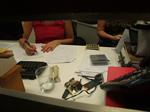 Very few people can immediately write a lucid and well-expressed piece of work. In most cases, the final draft is smoothed and polished so that others can readily understand the writer’s message. It is the editor’s role to improve the quality of the writing, whether their own or someone else’s work.
Very few people can immediately write a lucid and well-expressed piece of work. In most cases, the final draft is smoothed and polished so that others can readily understand the writer’s message. It is the editor’s role to improve the quality of the writing, whether their own or someone else’s work.
The scope of editing ranges from self editing, where the writer examines their writing and improves it as best they can, to professional editing, where an expert is employed by a publishing company to improve the quality of a piece of writing prior to publication.
There are many other facets of commercial publishing that require the skills of professional editors. These include commissioning publications; reviewing manuscripts; overseeing manuscripts through the production process; liaising with writers, publishers, printers and agents; writing blurbs, captions and press releases; and researching and organising pictures. In smaller organisations the editor may also be responsible for the design and publication of documents, newsletters, reports, magazines and books using desktop publishing software and equipment.
Editing involves several stages, which will be examined in detail during this course. In summary, they are:
1. Reviewing the manuscript
2. Structural (substantive) editing
3. Copy editing
4. Proof reading
5. Checking proofs.
WHAT DOES AN EDITOR DO?
Every editing job is different in some respect from others, and different editors may be responsible for different tasks. In general, editors do any or all of the following (or may delegate some tasks to others):
*Correct language errors, such as poor grammar, incorrect spelling and punctuation, and ambiguities.
*Identify technical inaccuracies (eg. in a non-fiction book.)
*Improve conciseness and clarity, if and where this is of significance.
*Identify potential legal problems, such as plagiarism, ethical or moral problems, copyright infringements, defamation risks.
*Check for uniformity and appropriateness of content and style, and make or recommend adjustments if necessary.
*Determine whether the content of a manuscript should be deleted or replaced (usually with approval from both the author and publisher).
*Determine whether additional content is required within a manuscript (usually with approval from both the author and publisher).
*Determine the order in which the manuscript is to be published.
*Liaise with all other persons involved in the production of the publication.
*Check and clear copyright material to be used in the publication (for instance, anything which is not the original work of the author should be properly referenced and used only in accordance with the law in any jurisdiction relevant to the publication).
*Prepare preliminary pages and cover, and mark up any end matter, usually in collaboration with the author.
*Prepare instructions for others involved in production, such as the designer, illustrator, typesetter and printer. (This may involve marking up the manuscript, preparing a series of ‘briefs’ and, in some cases, contract or tender documents.)
*Select illustrations, including photographs, tables and drawings from material submitted by the author.
*Identify and source additional illustrations if required (from the author or elsewhere).
*Write marketing material if required (often in collaboration with the author and/or the marketing staff).
*Monitor (and sometimes control) production schedules.
*Check proofs at each stage of production.
*Maintain a record of corrections after production for use in any reprints or new edition.
Foundation Course in Editing: Editing I click for outline or to enrol
To improve editing skills beyond the basics, study EDITING II (click for details)